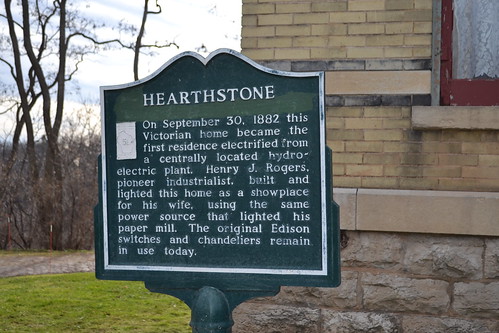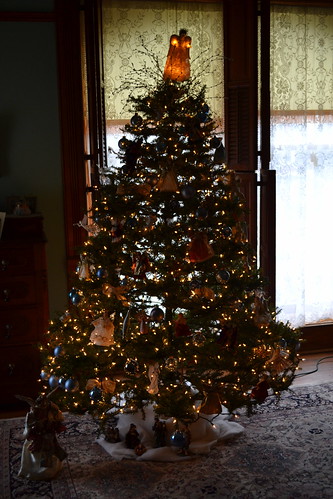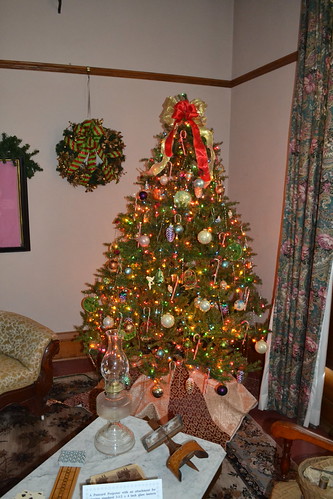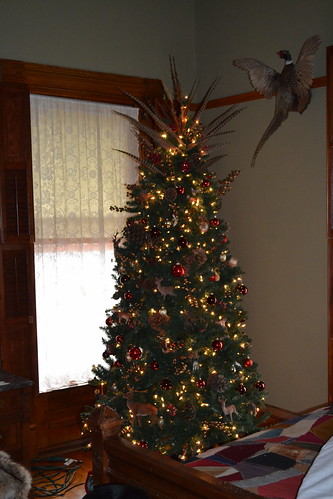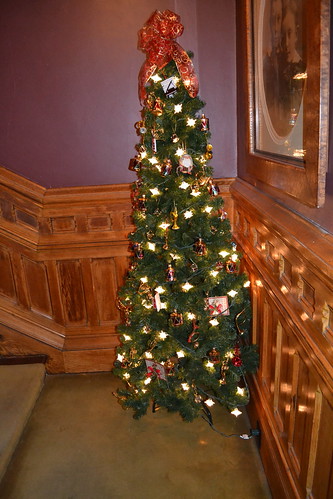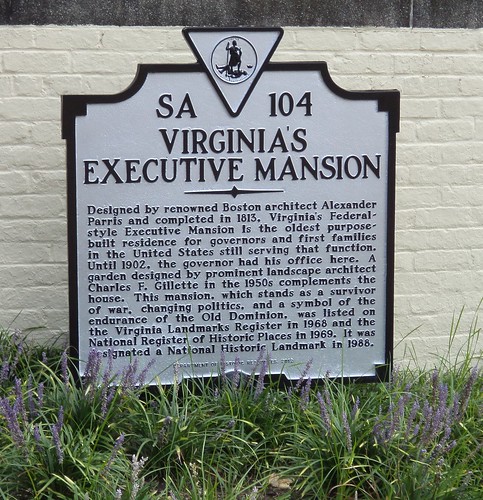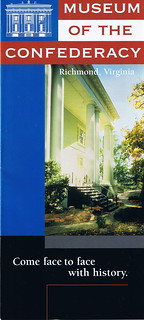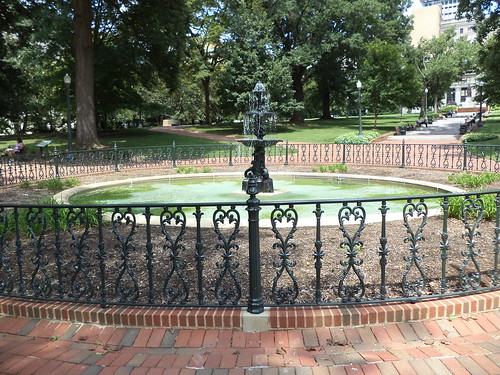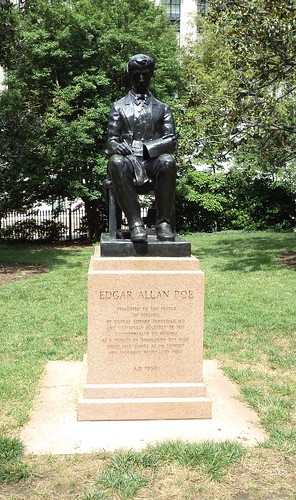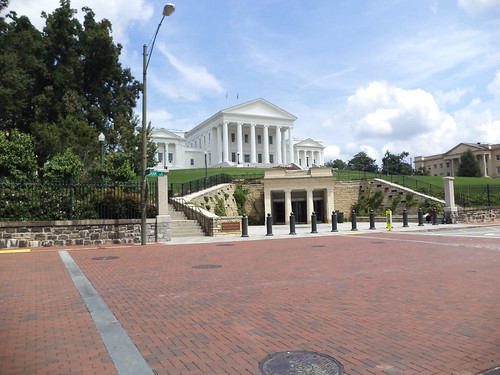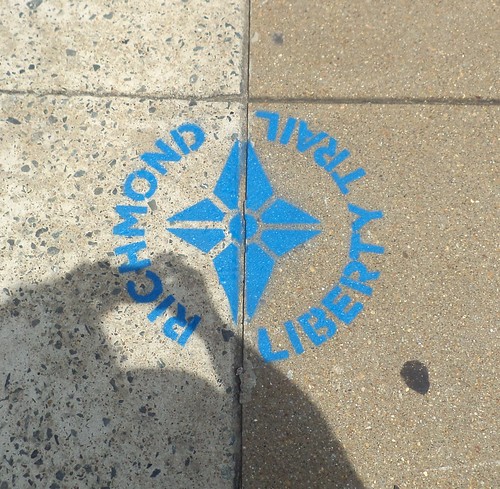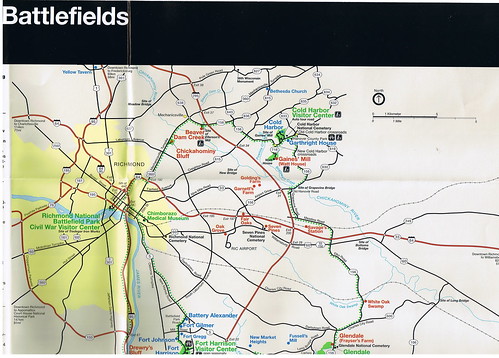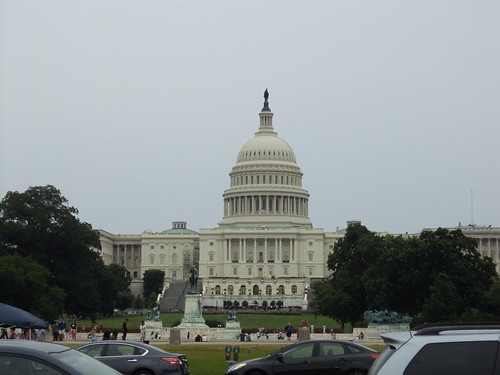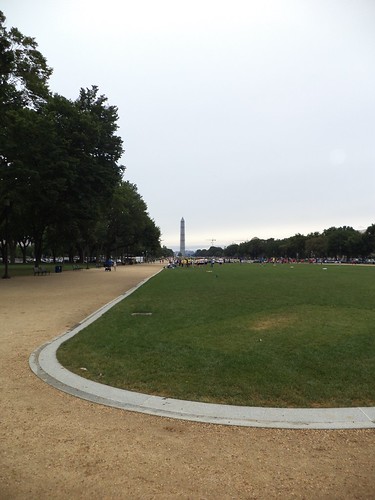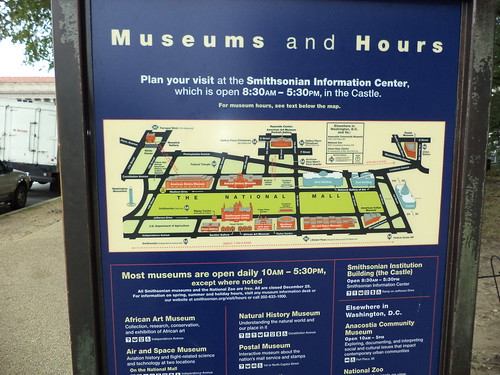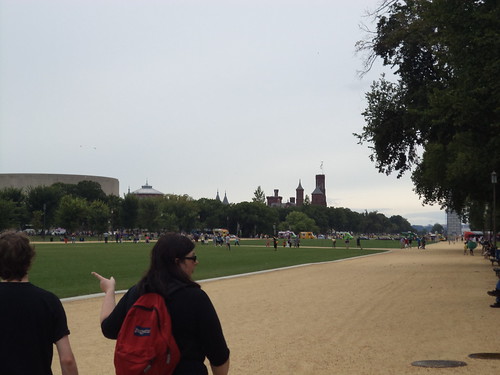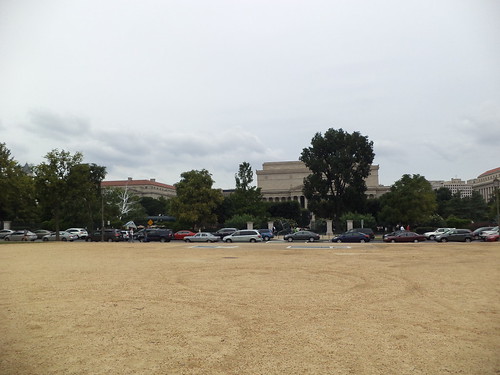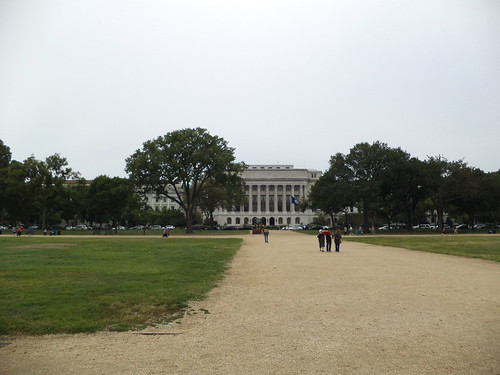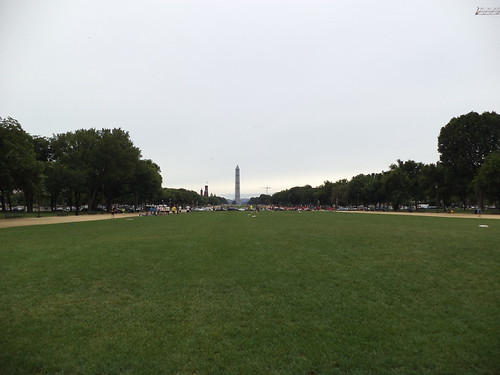There are no decorations up at my house. There is a box of unopened gifts, sent by Carole and Larry, under the table in the living room. Other than those and the cards with their envelopes stacked on top of the table, you'd never know it was Christmas when you walked in the door.
It's very hard to be motivated to decorate in any fashion when you're traveling and you're tired. I have a couple of new ornaments I'd love to display this year, and I had every intention of doing just that, but fate, and work, had other plans. At night, I can see the decorations of neighbors and, frankly, am content to have that be Christmas this year.
One of the best things about my job is getting to go behind the scenes, or during off hours, of places the public only sees on the days these places are open. Museums and monuments have always fascinated me. I enjoy history and being allowed to do my "thing" solo or accompanied by maybe a maintenance person, is a joy. Recently, I needed to inspect this museum.
This house, built in 1882, was the first private home, in the world, to be lit by these new-fangled electric light things. The home is huge. It was fascinating to me to wander about, as I'm looking for defects, and try to imagine what life was like to live in a house this big.
It's decorated for Christmas, too, so while I am not decorating, I could celebrate vicariously through the trees in the home.
This one was on the first floor in a study.
Since I wasn't part of any organized tour and the staff had other work to do, I don't know how much of the decorations on these trees are historical.
I didn't get photos of the huge trees on the first floor other than the one in the study because it didn't occur to me, until I was on the second floor, that I could document these and blog about them.
This is one on the second floor in a bedroom.
Of course there would not have been the lights. I only know about "historical" decorations from movies such as Meet Me In St. Louis, where the "lights" were actual candles wired to the tree branches.
Another tree in another bedroom.
What were the decorations in a home of this opulence? I suspect the ribbons could have been used. Were there trees in every room, too? This was in the father's room.
It seems it would have been way overkill and that this is a convention for the holiday as befitting a museum. The above tree has phesant feathers at the top.
This tree has more nature-based ornamentation than others. The large brown blobs are dried hydrangea blossoms. What's also neat about this photo is the background wall color. This burgundy red, I was told, was one of the original colors of the home. I was quite surprised to hear this.
This is a tree in the stairwell.
This burgundy worked very well with all the wood on the first floor and in the stairwells. (It's a three-story building.) I was told that during renovations, sections of old paint were flaked off and this color was found as a bottom color. Doesn't that look like a very modern color rather than something with roots in the 1880's?
This is a color of the rich. Red was hard to make. In everything from textiles to glass wear, red items meant you had money. I knew that 'royal' blue and 'royal' purple gained their monikers because the dyes used to achieve those deep colors were so expensive, only royalty could afford them. It never occurred to me that this burgundy would be a color of status.
Did they pack in the ornaments as these are decorated? Some of the glass globes, I recognized from the globes I have which were my great-grandparents. Because the building did not become a museum until the 1980's, many of the decorations appear to be from the time period the building was opened to the public. There are a lot of reproduction ornaments available to achieve a historic-looking decorated tree.
So this is my exposure to Christmas this year. It's kind of funny, but there was a great sense of peace about the house. There were no other people in the building besides me and 3 staff members. The museum had a hectic schedule ahead of school tours and is a great resource to the Appleton, Wisconsin community about life at the turn of the last century as well as a connection to Thomas Edison and the development of the electric light.
Without a lot of people in the building, I could stand and just be. I did have a laugh at one point. When I walked into the father's bedroom to look at the floors, walls and ceilings, I had this distinct feeling I was being watched. I turned to my left and saw this.
Even the fox is decorated.
Beverage: Dr Pepper
Deb
Showing posts with label museums. Show all posts
Showing posts with label museums. Show all posts
Thursday, December 17, 2015
Historical Christmas
Labels:
Carole,
Christmas,
Christmas tree,
color,
decorations,
history,
inspections,
Larry,
museums,
work
Thursday, September 25, 2014
Opening Tomorrow
I get to go amazing places and non-amazing places with my job. One of today's locations was a repeat of the space from back in March, those balmy days in March when it was in the 70's and we were starting this crazy project. We're back in the same spaces and people seem to be reasonably understanding about it. It's one of those, "When it's done, it will be wonderful. It's just the getting to the done part that's awful."
Anyway, today's trek started at the National Hellenic Museum at the edge of Chicago's Greektown Neighborhood.
The museum is located at the corner of Halsted and Van Buren, just off Chicago's downtown, just west of the Kennedy Expressway. You can see the Kennedy from the west side of the museum. We had to invade their space and stick 2 more monitors in the building and I had to inspect the south side again. The previous visit was to an empty exhibit space. It's not that way right now.
We could see, yesterday, when we walked by the museum on the way to lunch, the staff doing the finishing installation of this exhibit. It opens tomorrow, Friday, so there is much scurrying about to get things ready.
The Beetroot Design Group has imagined monsters from Greek mythology and put them in a black, red and white color scheme. The result is, I think, fantastic, and hugely playful.
Look. A cyclops, with sheep.
How about a phoenix rising from the flames?
Or maybe you'd like a minotar, kneeling, wondering what you're doing in the middle of his maze. He was just eating his hay and you've walked in and disturbed him. (That's Gene and our client in the background waiting for the machine to call in.)
Anyway, today's trek started at the National Hellenic Museum at the edge of Chicago's Greektown Neighborhood.
The museum is located at the corner of Halsted and Van Buren, just off Chicago's downtown, just west of the Kennedy Expressway. You can see the Kennedy from the west side of the museum. We had to invade their space and stick 2 more monitors in the building and I had to inspect the south side again. The previous visit was to an empty exhibit space. It's not that way right now.
We could see, yesterday, when we walked by the museum on the way to lunch, the staff doing the finishing installation of this exhibit. It opens tomorrow, Friday, so there is much scurrying about to get things ready.
The Beetroot Design Group has imagined monsters from Greek mythology and put them in a black, red and white color scheme. The result is, I think, fantastic, and hugely playful.
Look. A cyclops, with sheep.
How about a phoenix rising from the flames?
Or maybe you'd like a minotar, kneeling, wondering what you're doing in the middle of his maze. He was just eating his hay and you've walked in and disturbed him. (That's Gene and our client in the background waiting for the machine to call in.)
There are giant panels of painted artwork, too big for me to get into one frame of the camera.
And pieces which would fit on a pedastle in one's living room
I would buy a miniature of this piece. It's a black cat. I really love the bold colors.
Each piece will be accompanied by the name of the monster represented, a poem and a brief few paragraphs about the monster. My Greek and Roman Mythology class, so very long ago, failed me, for I couldn't remember the monster in the painting nor the cat. The minotar and the cyclops are very familiar by virtue of their use in other art and stories.
As much as I love the cat, these are, hands down, the stars of the exhibit, for me.
Look at these. If this doesn't bring a smile to your face, you're too far gone. Chickens, flying chickens. You can see a graphic representation panel of all the monsters they have designed at the lower right. It's 35 feet long and 7 feet high. It was fun to just stand there and admire the images. These are representations of the Stymphalian Birds. Dealing with them was Hercules' sixth labor. According to the myth their feathers are bronze and they can shoot them like arrows. Their beaks are like swords and they fly at anyone who comes to kill them. Their poop is highly toxic and will kill people who touch it. They were terrorizing the town of Stymphalia and needed to be eradicated.
Chickens. That's what theses are. I laughed. It was so fun to stand under them and just watch. When you heard the air conditioning come on, which you'd probably not hear at the start of the opening due to people noise, you could watch a very faint sway to the birds as you stood looking. It was not hard to imagine a flight of millions of these. I think I would be laughing too hard to do much about them.
I am sorely tempted to return to the museum to see the final installation. I also have to admit that I'd pay money for a cat and a chicken. I love art that's imaginative and this certainly is. If you're a reader from the Chicagoland, NW Indiana, SW Michigan or SE Wisconsin area, do come and see this. It's delightful.
Beverage: Water
Deb
Labels:
Art,
Chicago,
Indiana,
Michigan,
monsters,
museums,
mythology,
National Hellenic Museum,
statues,
Wisconsin,
work
Thursday, October 24, 2013
A Capital History
An interesting item about Richmond's capital building. The Governor's Mansion is within steps of the capital building.
This building is, itself, historic. I didn't know this information.
I didn't look to see if there are tours of it. When Carole was named a Lincoln Scholar while at North Central College, we got to have lunch in the Illinois Governor's Mansion. I didn't bring a camera that day. I don't know why, so I have only memories of a large room, painted a robin's egg blue, and filled with scholars and their families. I'm wondering if the Virginia mansion has a Christmas tour. If so, I'll bet it's very nice. Something to consider.
There is a second executive mansion in Richmond. This one is located 3 blocks northeast of the capital building.
The building itself is rather unassuming, although you can tell it's old even if you didn't know what it was.
In 2001, we took the tour of the building. I don't remember anything about the tour. The building is conveniently located next to the Museum of the Confederacy.
You get your tickets for the house tour inside the museum and then walk across the lot to the building. I thought we went in the front door when we were there in 2001, but the tour I saw went in through the back door, through the back garden. I did not take the tour because of the stairs involved and I was beginning to feel it in my knees. Plus, the museum had an exhibit I really wanted to spend time with.
Entitled "Gettysburg: They Walked Through Blood", it tells the story of Pickett's Charge through the flags of the regiments involved as well as letters and other artifacts. (This was the 150th anniversary of the Battle of Gettysburg.) Although there were quite a few people taking photos, I felt uncomfortable taking more than just this one. I don't even remember which regiment this is from. I needed to sit down as my knees were reminding me I must rest and this was in front of me.
What I found telling about this exhibit was how important it was to capture the battle flags of a regiment. Prior to this, I knew of battle flags and how they marked the different regiments involved in a battle. There were 15 battle flags involved in Pickett's Charge. Thirteen of them were captured. The Union gave out medals to men involved in capturing Southern flags. I have to say this fact bothered me. I realize it was a different time but awarding medals for capturing a flag of US citizens, even those under revolt, made an impression on me.
Captured flags were sent to the War Department and put into storage. Some of them had the names of the regiment written on them. It looked like magic marker but I was told it was black paint. In 1905, Congress gave those flags associated with Southern regiments to the museum. The first flag was donated in 1895 and, since then, they have accumulated a total of 685 flags. Considering these are 150 years old, the efforts of the museum to preserve them is especially noteworthy.
These flags were generally made from silk, as it took color better, was easier to sew and was a lighter weight than other materials. But silk is a fragile material. It tears easily and being taken into battle, a flag was subject to all sorts of stress from being rolled and unrolled and wadded up to even just being shot at. Add that some flags fell to the ground and were trampled until rescued and preservation consisted, early on, of simply sewing the flag to another piece of silk so all the pieces were kept together.
I was intrigued by how they hang a flag for display. I know about that thing called 'gravity'. If you've ever been in a house that is more than 100 years old and still has original windows, you will notice the glass in the windows is thicker at the bottom than at the top. Gravity is slowly pulling the glass to the bottom of the window. The same thing happens to anything vertically mounted. So how does a museum which has a huge number of flags display something so fragile? They buy specially created flag cases.
As a museum curator explained to me, the case is in three parts. There is a base and a pad. The flag is laid on this pad which is attached to the base. Then the top is carefully lowered onto the base over top of the flag and pad. It creates a sandwich. The flag, while still subject to gravity, can't move inside this mount. All the glass and the pad are archival quality, meaning there are no chemicals known to harm the fibers of the flag present in the mount. The mount is air tight and UV quality. While they would never hang the flag in direct sunlight, they can illuminate the flags with museum lighting. The best preservation would be to have the flags wrapped in archival tissue paper and lying flat in dark drawers in a climate controlled facility. But part of preservation, he said, is allowing the public to view these. For some people, who had relatives who marched under a certain flag, there is great meaning. This is, currently, the best possible way to show off flags in their collection. It's also very expensive.
So, I didn't take the tour of the Confederate White House and spent it pondering Pickett's Charge, among other things.
You see the pillar of the White House to the right. The museum is a small building set amongst the huge medical complex of Virginia Commonwealth University. When Carole and I were here in 2001, the land behind and to the left was open. The museum almost gets swallowed up in the medical complex.
A long time ago, I had an idea that, as a goal, it would be neat to tour the capital building and governor's mansion of all 50 states. I've never done anything with that idea. Perhaps, as my vacations will probably include a yearly trip to Virginia, I could start here.
Beverage: English Breakfast tea
Deb
This building is, itself, historic. I didn't know this information.
I didn't look to see if there are tours of it. When Carole was named a Lincoln Scholar while at North Central College, we got to have lunch in the Illinois Governor's Mansion. I didn't bring a camera that day. I don't know why, so I have only memories of a large room, painted a robin's egg blue, and filled with scholars and their families. I'm wondering if the Virginia mansion has a Christmas tour. If so, I'll bet it's very nice. Something to consider.
There is a second executive mansion in Richmond. This one is located 3 blocks northeast of the capital building.
The building itself is rather unassuming, although you can tell it's old even if you didn't know what it was.
In 2001, we took the tour of the building. I don't remember anything about the tour. The building is conveniently located next to the Museum of the Confederacy.
You get your tickets for the house tour inside the museum and then walk across the lot to the building. I thought we went in the front door when we were there in 2001, but the tour I saw went in through the back door, through the back garden. I did not take the tour because of the stairs involved and I was beginning to feel it in my knees. Plus, the museum had an exhibit I really wanted to spend time with.
Entitled "Gettysburg: They Walked Through Blood", it tells the story of Pickett's Charge through the flags of the regiments involved as well as letters and other artifacts. (This was the 150th anniversary of the Battle of Gettysburg.) Although there were quite a few people taking photos, I felt uncomfortable taking more than just this one. I don't even remember which regiment this is from. I needed to sit down as my knees were reminding me I must rest and this was in front of me.
What I found telling about this exhibit was how important it was to capture the battle flags of a regiment. Prior to this, I knew of battle flags and how they marked the different regiments involved in a battle. There were 15 battle flags involved in Pickett's Charge. Thirteen of them were captured. The Union gave out medals to men involved in capturing Southern flags. I have to say this fact bothered me. I realize it was a different time but awarding medals for capturing a flag of US citizens, even those under revolt, made an impression on me.
Captured flags were sent to the War Department and put into storage. Some of them had the names of the regiment written on them. It looked like magic marker but I was told it was black paint. In 1905, Congress gave those flags associated with Southern regiments to the museum. The first flag was donated in 1895 and, since then, they have accumulated a total of 685 flags. Considering these are 150 years old, the efforts of the museum to preserve them is especially noteworthy.
These flags were generally made from silk, as it took color better, was easier to sew and was a lighter weight than other materials. But silk is a fragile material. It tears easily and being taken into battle, a flag was subject to all sorts of stress from being rolled and unrolled and wadded up to even just being shot at. Add that some flags fell to the ground and were trampled until rescued and preservation consisted, early on, of simply sewing the flag to another piece of silk so all the pieces were kept together.
I was intrigued by how they hang a flag for display. I know about that thing called 'gravity'. If you've ever been in a house that is more than 100 years old and still has original windows, you will notice the glass in the windows is thicker at the bottom than at the top. Gravity is slowly pulling the glass to the bottom of the window. The same thing happens to anything vertically mounted. So how does a museum which has a huge number of flags display something so fragile? They buy specially created flag cases.
As a museum curator explained to me, the case is in three parts. There is a base and a pad. The flag is laid on this pad which is attached to the base. Then the top is carefully lowered onto the base over top of the flag and pad. It creates a sandwich. The flag, while still subject to gravity, can't move inside this mount. All the glass and the pad are archival quality, meaning there are no chemicals known to harm the fibers of the flag present in the mount. The mount is air tight and UV quality. While they would never hang the flag in direct sunlight, they can illuminate the flags with museum lighting. The best preservation would be to have the flags wrapped in archival tissue paper and lying flat in dark drawers in a climate controlled facility. But part of preservation, he said, is allowing the public to view these. For some people, who had relatives who marched under a certain flag, there is great meaning. This is, currently, the best possible way to show off flags in their collection. It's also very expensive.
So, I didn't take the tour of the Confederate White House and spent it pondering Pickett's Charge, among other things.
You see the pillar of the White House to the right. The museum is a small building set amongst the huge medical complex of Virginia Commonwealth University. When Carole and I were here in 2001, the land behind and to the left was open. The museum almost gets swallowed up in the medical complex.
A long time ago, I had an idea that, as a goal, it would be neat to tour the capital building and governor's mansion of all 50 states. I've never done anything with that idea. Perhaps, as my vacations will probably include a yearly trip to Virginia, I could start here.
Beverage: English Breakfast tea
Deb
Richmond
Richmond, Virginia is an old city. Living in the Midwest, we can often overlook the fact that when we consider "old", say early 19th century, the east coast has places 200 years older than that. The locality we know as Richmond is a case in point. There was a settlement in the vicinity in 1609. The present city was founded in 1737.The James River runs just south of the downtown. Carole lives in a suburb and commutes about 15 minutes into downtown Richmond.
It's rather ironic that, in 2001, we visited Richmond for her post-high school graduation Civil War battlefields vacation. We stayed at a luxury hotel right off capitol square in downtown. (The hotel is still there. I forgot to photograph it when I was there.) This was the view from our hotel window in the morning.
The white speckles on the tree in the foreground are magnolia blossoms. The actual capitol building is in the upper center.
We were in Richmond to visit the Museum of the Confederacy. At the time, they were mounting the biggest exhibit assembled to date, of Robert E. Lee memorabilia. We knew nothing of this museum, in fact, the article where we noticed the exhibit called it an "unknown gem". Given the feelings provoked by the Civil War, a museum dedicated to the Confederacy could be a lightning rod for all sorts of ideas. As 'Northerners', we have our own feelings about this time in US history. Carole had done some research on the war and felt that Robert E. Lee's personal conflict was not as examined as it should be. She really wanted to see this exhibit, so we amended our travel route and added Richmond to the itinerary.
The exhibit was incredible. Lee was a much decorated and respected general when the war broke out. It's well-known that he chose to go with the Confederacy because Virginia, his home state, seceded from the union. It did not make him happy. He fought against people he considered friends. I remember seeing letters from Lee to friends where he talked about his anguish. I believe there were uniforms, weapons, paintings and Lee's death mask. We came away from the exhibit with a new-found appreciation of just how much the war took a toll on Lee personally. And we found the museum to be simply a repository for items from that conflict. They don't really get into the whys or the ramifications of the war. They present what they have as 'this is what this is'. It really is a gem of a museum and I would urge you to go visit if you're close by.
It's a three block walk from the Virginia capitol building. The park surrounding the capitol is very nice. In 2001, I took this photo as we walked from our hotel to the museum.
The steps lead to a statue of George Washington. In 2013, the fountain is still there.
The steps still lead to a statue of George Washington.
There's a small statue of Poe sitting off to the side. I don't remember seeing this before.
We did not take the capitol tour in 2001 as we were there for one specific reason. There is a new entry to the capitol building and it advertised tours. I didn't take the tour either as I was in downtown for two specific reasons; to see where Carole works and to visit the museum again.
I'm a big one on maps and certainly appreciate when an area is presented visually.
I entered the area of the capitol from the upper right of the map and walked to the lower left. Carole can see the building from her office area.
There is so much history here. I encountered this memorial plaque as I was walking to Carole's office.
This talks about the fires set by Confederate soldiers in April of 1865 as the Union army closed in on the city. Carole mentioned that several of the signers of the Declaration of Independence, including George Washington and Thomas Jefferson, were meeting in Richmond at a time when the British army was approaching the city. Thanks to some fast thinking, the army was delayed just enough to get those men out of Richmond and to Charlottesville, 70 miles west of Richmond. Had they not been warned to leave, the Revolutionary War might have been a mere skirmish. It's easy to forget that part of Richmond's history as so much was tied up in the Civil War. To rectify that, Richmond developed the Richmond Liberty Trail.
This is painted on the sidewalk. This is self-guided and goes all over downtown Richmond. There is no real beginning to the trail. I must have seen a half-dozen of these on the sidewalk in my walk. Further research indicates this trail overlaps with two other walking trails, both self-guided. It's so easy to forget that the US history here predates items with which I'm familiar.
I wanted to visit Cold Harbor Battlefield while I was there. In 2001, we visited Tredegar Iron Works, which is the 'official' starting location for Civil War tours in Richmond.
But, on Wednesday, when I set out, I copied one direction wrong and ended up in an area that didn't seem right. After driving around for an hour, I never did find the battlefield and felt that I could get myself horribly lost so, when I found I-95, I headed back to Carole's. It was only when I was looking through our 2001 trip that I found the battlefield map we'd picked up. I should have brought it along.
When you combine the history from Revolutionary War days with Civil War days, there is a lot to see. It appears Carole is going to be settled in this area for the foreseeable future, perhaps this is now her home. With enough visits, I can maybe get around to all these places. And the walking is good for me.
Beverage: English Breakfast tea
Deb
It's rather ironic that, in 2001, we visited Richmond for her post-high school graduation Civil War battlefields vacation. We stayed at a luxury hotel right off capitol square in downtown. (The hotel is still there. I forgot to photograph it when I was there.) This was the view from our hotel window in the morning.
The white speckles on the tree in the foreground are magnolia blossoms. The actual capitol building is in the upper center.
We were in Richmond to visit the Museum of the Confederacy. At the time, they were mounting the biggest exhibit assembled to date, of Robert E. Lee memorabilia. We knew nothing of this museum, in fact, the article where we noticed the exhibit called it an "unknown gem". Given the feelings provoked by the Civil War, a museum dedicated to the Confederacy could be a lightning rod for all sorts of ideas. As 'Northerners', we have our own feelings about this time in US history. Carole had done some research on the war and felt that Robert E. Lee's personal conflict was not as examined as it should be. She really wanted to see this exhibit, so we amended our travel route and added Richmond to the itinerary.
The exhibit was incredible. Lee was a much decorated and respected general when the war broke out. It's well-known that he chose to go with the Confederacy because Virginia, his home state, seceded from the union. It did not make him happy. He fought against people he considered friends. I remember seeing letters from Lee to friends where he talked about his anguish. I believe there were uniforms, weapons, paintings and Lee's death mask. We came away from the exhibit with a new-found appreciation of just how much the war took a toll on Lee personally. And we found the museum to be simply a repository for items from that conflict. They don't really get into the whys or the ramifications of the war. They present what they have as 'this is what this is'. It really is a gem of a museum and I would urge you to go visit if you're close by.
It's a three block walk from the Virginia capitol building. The park surrounding the capitol is very nice. In 2001, I took this photo as we walked from our hotel to the museum.
The steps lead to a statue of George Washington. In 2013, the fountain is still there.
The steps still lead to a statue of George Washington.
There's a small statue of Poe sitting off to the side. I don't remember seeing this before.
We did not take the capitol tour in 2001 as we were there for one specific reason. There is a new entry to the capitol building and it advertised tours. I didn't take the tour either as I was in downtown for two specific reasons; to see where Carole works and to visit the museum again.
I'm a big one on maps and certainly appreciate when an area is presented visually.
I entered the area of the capitol from the upper right of the map and walked to the lower left. Carole can see the building from her office area.
There is so much history here. I encountered this memorial plaque as I was walking to Carole's office.
This talks about the fires set by Confederate soldiers in April of 1865 as the Union army closed in on the city. Carole mentioned that several of the signers of the Declaration of Independence, including George Washington and Thomas Jefferson, were meeting in Richmond at a time when the British army was approaching the city. Thanks to some fast thinking, the army was delayed just enough to get those men out of Richmond and to Charlottesville, 70 miles west of Richmond. Had they not been warned to leave, the Revolutionary War might have been a mere skirmish. It's easy to forget that part of Richmond's history as so much was tied up in the Civil War. To rectify that, Richmond developed the Richmond Liberty Trail.
This is painted on the sidewalk. This is self-guided and goes all over downtown Richmond. There is no real beginning to the trail. I must have seen a half-dozen of these on the sidewalk in my walk. Further research indicates this trail overlaps with two other walking trails, both self-guided. It's so easy to forget that the US history here predates items with which I'm familiar.
I wanted to visit Cold Harbor Battlefield while I was there. In 2001, we visited Tredegar Iron Works, which is the 'official' starting location for Civil War tours in Richmond.
But, on Wednesday, when I set out, I copied one direction wrong and ended up in an area that didn't seem right. After driving around for an hour, I never did find the battlefield and felt that I could get myself horribly lost so, when I found I-95, I headed back to Carole's. It was only when I was looking through our 2001 trip that I found the battlefield map we'd picked up. I should have brought it along.
When you combine the history from Revolutionary War days with Civil War days, there is a lot to see. It appears Carole is going to be settled in this area for the foreseeable future, perhaps this is now her home. With enough visits, I can maybe get around to all these places. And the walking is good for me.
Beverage: English Breakfast tea
Deb
Labels:
battlefield,
Carole,
Civil War,
fountain,
map,
museums,
park,
Revolutionary War,
Richmond,
statues,
travel,
vacation,
Virginia,
walking
Wednesday, October 16, 2013
The Nation's Yard
Because of the unpleasantness of a government shut-down, there has been a minor discussion about The National Mall. The Merriam-Webster dictionary defines "mall" thusly:
it is a walk of 1.2 miles. Along the way, the nation's heritage is available for all to see and visit. All these buildings were closed during the shut down. As the mall gets upwards of 24 million visitors a day, that's a lot of people unable to see and experience who we are.
Air and Space is toward the middle of this section of the Mall. The "castle" is near the Washington Monument.
This is the National Museum of American History. This building is huge. It's also located near the Washington Monument, across the Mall from the Smithsonian castle.
This is the National Gallery of Art-West Building. I could see spending a whole day just in the west and east buildings.
This is the National Museum for Natural History. This is another place I could spend an entire day. I know me.
There are other buildings that I didn't think to write down their names. Phil thought this was the National Archives. I drool at the thought of being surrounded by the nation's important documents.
And there's this building which is, Phil thought, a part of the administration of the Smithsonian's various museums.
Joining this august array will, in June of 2014, be the National Museum of African-American History and Culture. It will be located just a block north of the Washington Monument.
Yes, the garbage cans in this area were overflowing, but you could get anything you desired to eat, anything. If you wanted it and it wasn't on a food truck, you didn't want it. We had eaten before walking so I didn't check out the prices for viands. It was amazing, however, to see so many food options in two blocks.
Having walked the nearly 2 miles from end to end, I can say they do a fantastic job. The Nation's Front Yard. Yes, that's an apt description.
Beverage: Dr Pepper
Deb
[The Mall, promenade in London, originally a pall-mall alley]
a : a usually public area often set with shade trees and designed as a promenade or as a pedestrian walk
b : a usually paved or grassy strip between two roadways
If you do a Google maps search for Washington DC, it's extremely easy to find the Capitol, the Washington Monument, The White House and the Lincoln Memorial. Just zoom in until you see a large expanse of green. Those places delineate The National Mall.
With the shut down, NPR did a brief discussion of just what this public space is and what does it mean for us. When you think of the protests, gatherings and events in Washington DC, this is the place to go. From the Captiol building on the east ...
... to the Washington Monument, ...
it is a walk of 1.2 miles. Along the way, the nation's heritage is available for all to see and visit. All these buildings were closed during the shut down. As the mall gets upwards of 24 million visitors a day, that's a lot of people unable to see and experience who we are.
As we walked west, I took photos of some of the buildings along the way. Having Phil with us was a great help. "What's that building?" I'd ask. "That's um...the National Portrait Gallery, I'm pretty sure," he'd respond. It wasn't until we got to the Washington Monument that there was an actual map of what museums lined the Mall.
This is the Smithsonian Air and Space Museum.
This is the iconic Smithsonian Castle. It was the original museum but now is administration.
Air and Space is toward the middle of this section of the Mall. The "castle" is near the Washington Monument.
This is the National Museum of American History. This building is huge. It's also located near the Washington Monument, across the Mall from the Smithsonian castle.
This is the National Gallery of Art-West Building. I could see spending a whole day just in the west and east buildings.
This is the National Museum for Natural History. This is another place I could spend an entire day. I know me.
There are other buildings that I didn't think to write down their names. Phil thought this was the National Archives. I drool at the thought of being surrounded by the nation's important documents.
And there's this building which is, Phil thought, a part of the administration of the Smithsonian's various museums.
Joining this august array will, in June of 2014, be the National Museum of African-American History and Culture. It will be located just a block north of the Washington Monument.
So many places to go and see. Spending a day in each one is not a far-fetched idea. All of these museums are free. They exist via our tax dollars and via membership. You may come and go as you like, picking and choosing which parts you will see on which day.
It seems, to me, to be right that the repositories of our heritage should be located along what could be termed our front lawn. When we were there, frisbee football events were taking place on sections of the mall. I look at photos from other large events and I think, "I know where that was. I was there."
I think one of the best examples of how much this is our park was seeing the lines of food trucks set up about half-way down the Mall.
Yes, the garbage cans in this area were overflowing, but you could get anything you desired to eat, anything. If you wanted it and it wasn't on a food truck, you didn't want it. We had eaten before walking so I didn't check out the prices for viands. It was amazing, however, to see so many food options in two blocks.
The National Park Service is tasked with keeping the space of green useable for all of us.
Having walked the nearly 2 miles from end to end, I can say they do a fantastic job. The Nation's Front Yard. Yes, that's an apt description.
Beverage: Dr Pepper
Deb
Subscribe to:
Posts (Atom)
